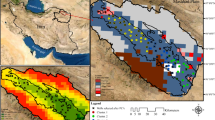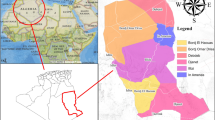Abstract
The simulation-random statistics (SRS) method is one of the effective approaches to solving groundwater contamination source identification (GCSI) challenges. In this paper, we applied a heuristic search iterative process (HSIP) based on SRS to provide interval estimation and probability distribution for an unknown variable to enhance our understanding of the unknown variable. Posterior distribution has been a subject of interest in HSIP; therefore, it is imperative to update prior distributions using final iterations obtained from posterior distributions, which has been seldom considered in previous research. This paper first proposed such updates and subsequently designed an updating HSIP (UHSIP). This paper first proposed a feedback correction step and incorporated it into UHSIP to achieve feedback improvements and simultaneous updates of an unknown variable and prior distribution. In UHSIP, a surrogate system such as extreme learning machine (ELM) is usually established for a numerical simulation model to reduce computational cost. The particle swarm optimization (PSO) algorithm has been demonstrated to optimize input weights and hidden layer biases in ELM. However, the PSO algorithm is prone to premature convergence and its calculation accuracy does not satisfy precision requirements when optimizing complex functions. To enhance accuracy, this paper first proposed a new adaptive chaotic PSO (ACPSO) algorithm to establish ACPSO–ELM surrogate system. The two newly proposed approaches were tested in two case studies based on groundwater inorganic and organic contaminations. Results reveal that UHSIP can effectively enhance identification accuracy, and ACPSO–ELM surrogate system has a higher approximation accuracy to the simulation model than PSO–ELM. Overall, the two main innovations in this paper (UHSIP and ACPSO–ELM surrogate system) present promising and effective solutions to GCSI challenge.



















Similar content being viewed by others
References
Asher MJ, Croke BFW, Jakeman AJ, Peeters LJM (2015) A review of surrogate models and their application to groundwater modeling. Water Resour Res 51(8):5957–5973
Chen C, Li W, Su H, Liu K (2014) Spectral-Spatial Classification of Hyperspectral Image Based on Kernel Extreme Learning Machine. Remote Sens 6(6):5795–5814
Datta B, Chakrabarty D, Dhar A (2011) Identification of unknown groundwater pollution sources using classical optimization with linked simulation. J Hydro-environ Res 5(1):25–36
Duan Q, Pappenberger F, Wood A, Cloke HL, Schaake JC (2019) Handbook of Hydrometeorological Ensemble Forecasting
Elmroth E, Ding C, Wu YS, Pruess K (1999) A parallel implementation of the tough2 software package for large scale multiphase fluid and heat flow simulations. Proceedings of Supercomputing Acm, 52
Forrester AIJ, Keane AJ (2009) Recent advances in surrogate-based optimization. Prog in Aerosp Sci 45(1–3):50–79
Guozhen W, Zhang C, Li Y, Haixing L, Zhou H (2016) Source identification of sudden contamination based on the parameter uncertainty analysis. J Hydroinform 18(6):919–927
Hou Z, Lu W, Chu H, Luo J (2015) Selecting Parameter-Optimized Surrogate Models in DNAPL-Contaminated Aquifer Remediation Strategies. Environ Eng Sci 32(12):1016–1026
Hou Z, Lu W (2018) Comparative study of surrogate models for groundwater contamination source identification at DNAPL-contaminated sites. Hydrogeol J 26(3):923–932
Hou Z, Dai Z, Lao W, Wang Y, Lu W (2019) Application of Mixed-Integer Nonlinear Optimization Programming Based on Ensemble Surrogate Model for Dense Nonaqueous Phase Liquid Source Identification in Groundwater. Environ Eng Sci 36(6):699–709
Huang GB, Zhu QY, Siew CK (2006) Extreme learning machine: Theory and applications. Neurocomputing 70(1–3):489–501
Jiang X, Lu W, Hou Z, Zhao H, Na J (2015) Ensemble of surrogates-based optimization for identifying an optimal surfactant-enhanced aquifer remediation strategy at heterogeneous DNAPL-contaminated sites. Comput Geosci-UK 84:37–45
Jiang S, Fan J, Xia X, Li X, Zhang R (2018) An Effective Kalman Filter-Based Method for Groundwater Pollution Source Identification and Plume Morphology Characterization. Water 10(8):1063
Kuan W (2019) Research on thermal storage and irrigation in Yanjin area based on tough2 numerical simulation software. Groundwater
Laloy E, Vrugt JA (2012) High-dimensional posterior exploration of hydrologic models using multiple-try DREAM(ZS) and high-performance computing. Water Resour Res 50(3):182–205
Laloy E, Rogiers B, Vrugt JA, Mallants D, Jacques D (2013) Efficient posterior exploration of a high-dimensional groundwater model from two-stage Markov chain Monte Carlo simulation and polynomial chaos expansion. Water Resour Res 49(5):2664–2682
Lapworth DJ, Baran N, Stuart ME, Ward RS (2012) Emerging organic contaminants in groundwater: A review of sources, fate and occurrence. Environ Pollut 163:287–303
Li J, Lu W, Wang H, Fan Y, Chang Z (2020) Groundwater Contamination Source Identification Based on a Hybrid Particle Swarm Optimization-Extreme Learning Machine. Journal of Hydrology, 124657
Li M, Huang X, Liu H, Liu B, Wu Y, Xiong A, Dong T (2013) Prediction of gas solubility in polymers by back propagation artificial neural network based on self-adaptive particle swarm optimization algorithm and chaos theory. Fluid Phase Equilibr., 356, 11–17
Li X, Mao W, Jiang W (2016) Extreme learning machine based transfer learning for data classification. Neurocomputing 174:203–210
Li L, Puzel R, Davis A (2018) Data assimilation in groundwater modelling: Ensemble Kalman filter versus ensemble smoothers. Hydrol Process 32(13):2020–2029
Luo J, Lu W, Xin X, Chu H (2013) Surrogate model application to the identification of an optimal surfactant-enhanced aquifer remediation strategy for DNAPL-contaminated sites. J Earth Sci 24(6):1023–1032
Luo J, Lu W (2014) Comparison of surrogate models with different methods in groundwater remediation process. J Earth Syst Sci 123(7):1579–1589
Massoud EC, Purdy AJ, Miro ME, Famiglietti JS (2018) Projecting groundwater storage changes in california’s central valley. Sci Rep 8(1):12917-
Massoud EC (2019) Emulation of environmental models using polynomial chaos expansion. Environ. Modell. Softw., 111(JAN.), 421–431
Mirghani BY, Zechman EM, Ranjithan RS, Mahinthakumar G (2012) Enhanced Simulation-Optimization Approach Using Surrogate Modeling for Solving Inverse Problems. Environmen Forens 13(4):348–363
Prakash O, Datta B (2012) Sequential optimal monitoring network design and iterative spatial estimation of pollutant concentration for identification of unknown groundwater pollution source locations. Environ Monit Assess 185(7):5611–5626
Shi X, Ye M, Curtis GP, Miller GL, Meyer PD, Kohler M, Yabusaki S, Wu J (2014a) Assessment of parametric uncertainty for groundwater reactive transport modeling. Water Resour Res 50(5):4416–4439
Shi Y, Zhao LJ, Tang J (2014b) Recognition Model Based Feature Extraction and Kernel Extreme Learning Machine for High Dimensional Data. Adv Mater Res 875:2020–2024
Singh RM, Datta B (2006) Identification of Groundwater Pollution Sources Using GA-based Linked Simulation Optimization Model. J Hydrol Eng 11(2):1216–1227
Smith T, Sharma A, Marshall L, Mehrotra R, Sisson S (2010) Development of a formal likelihood function for improved Bayesian inference of ephemeral catchments. Water Resour Res 46(12):3909–3914
Wang FK, Huang PR (2013) Implementing particle swarm optimization algorithm to estimate the mixture of two Weibull parameters with censored data. J Stat Comput Sim 84(9):1975–1989
Wang H, Jin X (2013) Characterization of groundwater contaminant source using Bayesian method. Stoch Env Res Risk A 27(4):867–876
Wang H, Lu W, Chang Z, Li J (2020) Heuristic search strategy based on probabilistic and geostatistical simulation approach for simultaneous identification of groundwater contaminant source and simulation model parameters. Stoch Env Res Risk A, 34(6), 891–907
Wang X, Han M (2014) Online sequential extreme learning machine with kernels for nonstationary time series prediction. Neurocomputing 145:90–97
Wong KI, Wong PK, Cheung CS, Vong CM (2013) Modelling of diesel engine performance using advanced machine learning methods under scarce and exponential data set. Appl Soft Comput 13(11):4428–4441
Xing Z, Qu R, Zhao Y, Fu Q, Ji Y, Lu W (2019) Identifying the Release History of a Groundwater Contaminant Source Based on an Ensemble Surrogate Model. J Hydrol 572:501–516
Zanini A, Woodbury AD (2016) Contaminant source reconstruction by empirical Bayes and Akaike’s Bayesian Information Criterion. J. Contam. Hydrol. 185–186, 74–86
Zeng XK, Ye M, Wu JC, Wang D, Zhu XB (2018) Improved nested sampling and surrogate-enabled comparison with other marginal likelihood estimators. Water Resour Res 54(2):797–826
Zhao Y, Lu W, An Y (2015) Surrogate model-based simulation-optimization approach for groundwater source identification problems. Environ Forensics 16(3):296–303
Zhao Y, Lu W, Xiao C (2016) A Kriging surrogate model coupled in simulation-optimization approach for identifying release history of groundwater sources. J. Contam. Hydrol., 185–186, 51–60
Zheng Q, Zhang J, Xu W, Wu L, Zeng L (2018) Adaptive Multi-fidelity Data Assimilation for Nonlinear Subsurface Flow Problems. Water Resour Res, 55(1), 203–217
Acknowledgements
This research was supported by the National Key Research and Development Program of China (No. 2018YFC1800405) and the National Natural Science Foundation of China (No. 41972252), the Graduate Innovation Fund of Jilin University (Nos. 101832020CX246, 101832020CX201).
Author information
Authors and Affiliations
Corresponding author
Ethics declarations
Conflict of interest
We declare that we do not have any commercial or associative interest that represents a conflict of interest in connection with the submitted manuscript.
Additional information
Publisher’s note
Springer Nature remains neutral with regard to jurisdictional claims in published maps and institutional affiliations.
Rights and permissions
About this article
Cite this article
Wang, H., Lu, W. & Chang, Z. An iterative updating heuristic search strategy for groundwater contamination source identification based on an ACPSO–ELM surrogate system. Stoch Environ Res Risk Assess 35, 2153–2172 (2021). https://doi.org/10.1007/s00477-021-01994-2
Received:
Revised:
Accepted:
Published:
Issue Date:
DOI: https://doi.org/10.1007/s00477-021-01994-2




